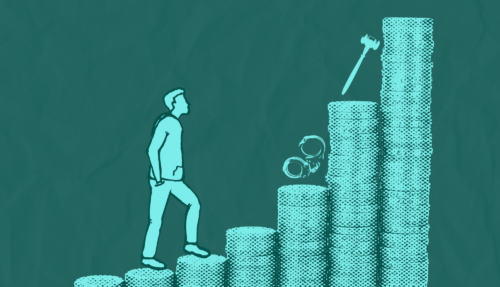Fines and fees add to the burden on people navigating the justice system, making it harder to get back on their feet. There’s a better path to safety.
Coming into contact with the justice system can have a wide range of collateral consequences, from job loss to custody issues to eviction. But for many people coming through the courts, there’s another challenge, too: fines and fees.
Sometimes called “legal financial obligations,” fines and fees are pervasive in the justice system. Fines, which are imposed as punishments after a violation or criminal conviction, can range from relatively low amounts for minor traffic offenses to tens of thousands of dollars for serious felonies. On top of that, courts often charge for various aspects of the legal process itself—like public defender fees, docketing fees, and criminal history checks. Court-ordered supervision can also come with third-party fees that cover the cost of mandatory drug tests, electronic monitoring, and other requirements.
These costs can keep people trapped in debt and prolong their involvement in the justice system, especially for those experiencing hardships like unemployment or poverty. If you can’t pay, you could have your driver’s license suspended, which can prevent you from getting to work and further destabilize your life. In some cases, you might even face wage garnishment or jail time.
In one recent study conducted in Jefferson County, Alabama, researchers from the Center and IBM worked with a local subject matter expert to detect disparities in the system using artificial intelligence. The team found that middle-aged Black men were more likely than any others in the legal system to face steep financial penalties for certain charges. The study built on prior research in Alabama showing that 83 percent of those impacted by fines and fees had given up basic necessities in order to make their payments.
Another report led by MDRC, also based in Jefferson County, found that financial penalties were higher for people who couldn’t afford an attorney—a striking example of how the heaviest burdens too often fall on those who are most vulnerable. Yet even as fines and fees put immense strain on people with limited resources, most of them go unpaid, and those impacted by crime are often the last to receive compensation.
Debt that exceeds a person’s ability to pay can exacerbate the basic challenges that bring people into court, put a burden on families, and erode public trust in the justice system. People living in poverty may be forced to pass up essentials like rent, food, or medical care in order to pay these costs. Since nonpayment is often punished with more debt and potentially incarceration, excessive fines and fees can also undermine public safety, leading to reoffending for people who are under pressure to come up with money and have very few options to earn it.
All of these harms disproportionately impact low-income communities and communities of color. And since a criminal record can hurt someone’s chances of finding a stable job, these responses to crime often create an ongoing spiral of hardship.
There is work going on to alleviate these burdens on people in the justice system, from local policy reforms to data-driven initiatives that evaluate people’s ability to pay before imposing fines. For nearly 30 years, our work in the courts has reduced the harms of fines and fees in another way: reimagining the justice system as an opportunity to address life challenges.
Our very first program, the Midtown Community Court—now the Midtown Community Justice Center—opened its doors in 1993 to respond to low-level crimes in a way that would put people on track for a better life. Instead of fines and jail time, participants could resolve their cases by performing community service and receiving on-site support for mental health needs, employment and housing challenges, substance use, and other issues that often lead up to an arrest.
The program served as a model for similar programs and initiatives across the country. Today, there are hundreds of community courts that work to address people’s underlying needs as a way to prevent crime and build safer, stronger communities. In neighborhoods across New York, we partner with the court system to operate Community Justice Centers that not only steer people away from typical punishments like fines, but also connect people to job support, financial empowerment workshops, housing services, and other resources that address the core challenges behind many criminal cases.
